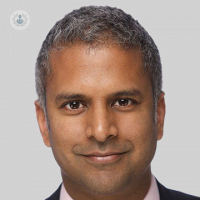Sinusitis or the common cold? Common types of sinus infections and how to distinguish between symptoms
Written in association with:While there is some overlap between the symptoms of the common cold or flu and sinusitis, there are several key features which distinguish a sinus infection from other types of respiratory conditions. In this informative guide, revered consultant ENT and head and neck surgeon Mr Priy Silva reveals how sinusitis symptoms differ, and sheds light on the most common types of sinus infections. The leading specialist also discusses key risk factors associated with sinusitis.

What is sinusitis?
Sinusitis is the inflammation or swelling of the tissue lining the sinuses. The sinuses are hollow spaces located in the bones of the face and head, which are connected to the nasal passages. They produce mucous, which helps to trap and remove particles like dust, bacteria, and other contaminants from the air we breathe. When sinuses become blocked and filled with fluid, germs (bacteria, viruses, and fungi) can grow and cause an infection.
What are the most common types of sinus infections?
Common types of sinus infections, based on their causative agents and their duration, include:
Viral sinusitis
This is the most common cause of sinusitis. It often begins as a common cold and then leads to inflammation and swelling that blocks the sinuses. Symptoms typically last less than 10 days, but if they last longer, it might indicate bacterial or other complications.
Bacterial sinusitis
Bacterial sinusitis occurs when bacteria invade the sinuses. Symptoms can be similar to viral sinusitis but usually last longer and can be more severe. Common bacteria that can cause sinusitis include Streptococcus pneumoniae, Haemophilus influenzae, and Moraxella catarrhalis.
Fungal sinusitis
Fungal sinusitis is less common than viral or bacterial sinusitis. People with compromised immune systems or certain chronic conditions like diabetes may be more susceptible. There are several types of fungal sinusitis, such as invasive and non-invasive (e.g. allergic fungal sinusitis).
What is considered chronic or recurrent sinusitis?
Based on the duration and frequency, sinusitis can be classified as:
Acute Sinusitis
- lasts up to 4 weeks
- symptoms include facial pain, nasal stuffiness, nasal discharge
- patients may also report cough, fever, bad breath, and dental pain
Subacute sinusitis
- symptoms last between 4 to 12 weeks
Chronic sinusitis
- symptoms last for more than 12 weeks and can persist for months or even years
Recurrent sinusitis
- multiple episodes of sinusitis within a year
- each episode typically does not last longer than four weeks
Identifying the type and cause of sinusitis is crucial because treatment can differ depending on the underlying cause. For instance, antibiotics can treat bacterial sinusitis but won't be effective against viral sinusitis.
If you suspect you have sinusitis, it is essential to consult your GP or an ENT specialist for a proper diagnosis and appropriate treatment recommendations.
How can the symptoms of sinusitis be distinguished from other respiratory conditions?
Sinusitis has symptoms that can overlap with other respiratory conditions, which can sometimes make it challenging to distinguish based solely on symptoms. However, there are specific signs and symptoms that can help differentiate sinusitis from other respiratory conditions. Symptoms indicative of sinusitis include:
- facial pain or pressure, felt in the forehead, between the eyes or in the cheekbones
- nasal discharge which is thick and yellow or greenish and comes from the nose or down the back of the throat (postnasal drip)
- nasal congestion - difficulty breathing through the nose
Other symptoms may include loss of smell and taste, fever, bad breath, pressure in the ears, headaches and tiredness.
To distinguish sinusitis from other respiratory conditions, it's helpful to look for the presence or absence of other symptoms or conditions that may sometimes mimic or overlap with the symptoms of sinusitis. This includes the common cold, allergic rhinitis, flu, asthma and pneumonia.
A dedicated healthcare professional will be able to diagnose the cause of your respiratory symptoms and advise on appropriate treatment. They might use additional methods (like imaging or physical examination) to differentiate between conditions. You may need to see an ENT specialist to exclude or confirm the presence of sinus disease.
What are the primary causes and risk factors associated with sinusitis?
The primary causes of sinusitis are typically related to infections which may be viral (such as the common cold), bacterial (for example, after a prolonged viral infection or due to blockage of the sinuses) or, less commonly, fungal.
Sinusitis may also be related to nasal polyps (soft grape-like swellings arising from the lining of the sinuses/nose), a deviated nasal septum or other medical conditions such as cystic fibrosis, gastroesophageal reflux or conditions that result in an increased risk of infection can also lead to sinusitis.
Risk factors include respiratory tract Infections, which can inflame and block the nasal passages, making it easier for a bacterial infection to take hold. Additionally, allergies or frequent exposure to pollutants can make a person more likely to develop sinusitis. Asthma sufferers are also at a higher risk of getting sinusitis. Other risks include a compromised immune system or dental infections, as infections in the upper teeth can spread to the sinuses.
To learn more about sinusitis diagnosis and treatment, read Mr Silva’s follow-up article on sinus infections.
If you are troubled by respiratory symptoms or are struggling with recurrent sinusitis, you can schedule a consultation with Mr Silva by visiting his Top Doctors profile.


